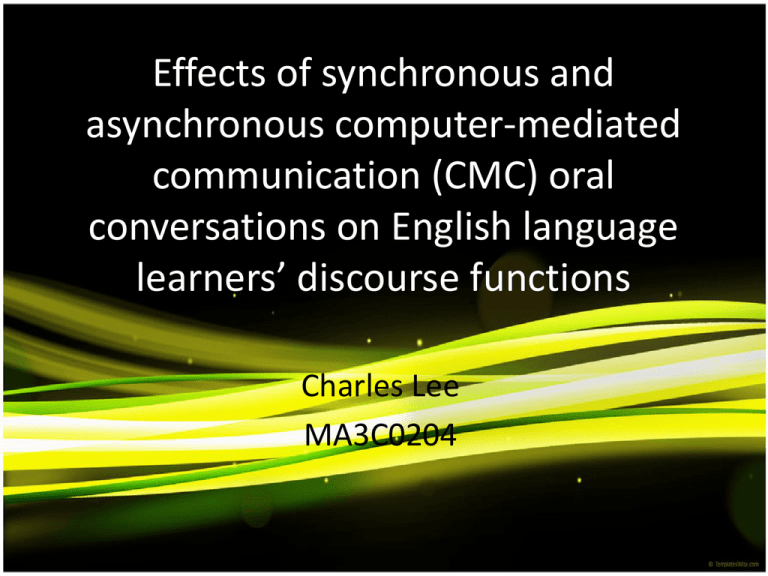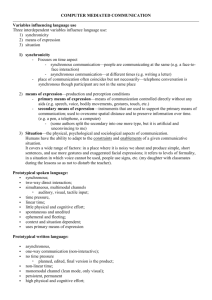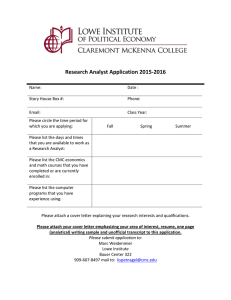Effects of synchronous and asynchronous computer-mediated communication (CMC) oral conversations on English language
advertisement

Effects of synchronous and asynchronous computer-mediated communication (CMC) oral conversations on English language learners’ discourse functions Charles Lee MA3C0204 Introduction Many language teachers have increasingly indulged in developing collaborative language learning activities using computermediated communication (CMC) synchronous asynchronous Synchronous and asynchronous CMC modes are used as an approach to help English as a Foreign Language (EFL) learners to create social interaction in and outside the classroom. The focus of the present study is to analyze the effects of synchronous and asynchronous CMC modes on question (types and strategies) discourse function generated by EFL learners. There are two major CMC modes: Synchronous and asynchronous which may serve different functions, and they may be used for various pedagogical purposes. Both mode can help students producing a large amount of language output. i) provide frequent opportunities for students to express their ideas and opinions; ii) produce large amount of target language output; iii) allow more time to develop comments, which may lead to greater precision of expression; iv) promote a collaborative spirit; v) enhance motivation for language practice; vi) promote student-centered atmosphere; vii) focus on content rather than form; viii) reduce students’ anxiety from face-to-face communication in a foreign language class; and ix) develop student’s linguistic performance. the asynchronous mode may give users more chances to think and answer than the synchronous mode where they participate in a real time interaction (Abrams, 2003). Synchronous CMC mode requires immediate responses which limit the use of outside resources while asynchronous CMC mode supports delayed interactions which give more time for thinking and planning and uses external resources. Synchronous Asynchronous telnet,BBS(talk),IRC Video conferencing Email, Voice mail ” In addition, different types of interaction (that is, synchronous and asynchronous) may affect the quality of feedback differently (Ho & Savignon, 2007). two research questions 1) Which CMC mode, synchronous or asynchronous, shows main question types of the output produced by EFL learners? 2) What are the effects of synchronous and asynchronous CMC modes on question strategies used by EFL learners? Participants-Students were native XXX speakers at an intermediate EFL level. They were surveyed about gender, age, computer literacy, and high school and university English level. They ranged in age from 19 to 21 years with the average age being 20.3 years. Research took place at the Department of English Language during a 6-week period. The class met once a week for 1.5 h each time. 30 students were randomly assigned to two treatment conditions/groups. The first group used synchronous CMC while the second utilized asynchronous CMC. Each group in synchronous and asynchronous CMC modes was then divided into smallsized cooperative groups of 5 students based on their selection of the group members. This study was conducted over a six-week period at XXX University. It involved two groups from an intact EFL class. Students were asked to make an oral discussion session in synchronous CMC mode and another oral discussion session using asynchronous CMC mode on six topics. The tasks aimed at developing students’ oral performance. Each student in the synchronous CMC group was required to discuss all topics orally, including discussing all subtasks in each topic and answering other students’ questions related to them through the Audio Chat module (Fig. 1), while students in the asynchronous CMC mode had to do the same tasks, but via sending audio messages. The topics included the following: 1) A journey: When/Where/Why/How/With whom did you go? What did you do/see/eat/drink/play, etc.? Describe the place. 2) Spending your day: Describe what you do (example, eat, study, watch, and meet) in the morning/at noon/in the evening. 3) Multiculturalism: What are the differences/similarities between your values and Western values? Give illustrative examples. Do you like/dislike them? Why? 4) Study problems: Describe the problems facing you in your study (example, study time, exams, fees, assignments, professors, schedule, etc.) 5) Friendship: Describe your friend. What are the characteristics of the good friend? Has he/she ever helped you? How? What should we do to keep friends? 6) Car accidents: Why do drivers make accidents? What are the results? What is the effect of car accidents on children/students? Suggest solutions for the problem. Describe a car accident you saw. Students were asked to talk or to make conversation base on these types of questions. Students’ conversations were saved for later logging, and then transcribed and analyzed by two analysts who were applied linguists. And giving grades base on the following figure After gather the data they use SPSS to run ANOVA Based on the findings in this study, it can be concluded that learners who used asynchronous CMC mode performed significantly better than those who used synchronous CMC mode on measures of mean of question types and strategies, and their totals. The use of asynchronous CMC mode helped students to generate more discourse related to question types and strategies. This was an unexpected finding and against the results reported by many studies done to identify the effects of synchronous and asynchronous CMC modes. Criticizing of this paper • The author did not really point out what kind of the equipment is using for the group of the asynchronous students. . Each student in the synchronous CMC group was required to discuss all topics orally, including discussing all subtasks in each topic and answering other students’ questions related to them through the Audio Chat module (Fig. 1) • the study was conducted on a limited sample over a limited period in a particular context -30 students 1.5 hours per week. • The data of the study was graded based on the analyze of the two applied linguists. It should have Questionnaire of the students to involve their opinions.


